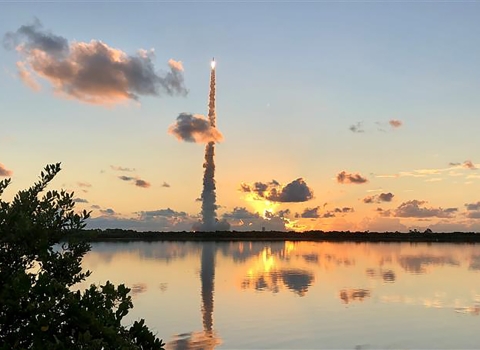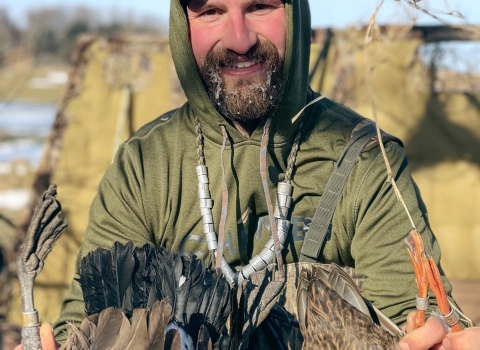What action is the U.S. Fish and Wildlife Service taking?
The Service is designating critical habitat for the Suwannee moccasinshell under the Endangered Species Act (ESA).
What is the range of the Suwannee moccasinshell?
The Suwannee moccasinshell, a small freshwater mussel, was historically present throughout much of the Suwannee River Basin, including the Suwannee River main stem in Florida, Santa River sub-basin in Florida, and the Withlacoochee River in Florida and Georgia. The current range of the Suwannee moccasinshell now only includes the middle Suwannee River and the lower Santa Fe River. Recent surveys targeting the species indicate it has declined in abundance and range and that it may be extirpated from the Withlacoochee River and upper Santa Fe River sub-basin.
What areas were designated Suwannee moccasinshell critical habitat?
The Service is designating Suwannee moccasinshell critical habitat in three separate units across approximately 190 miles of stream channel in Alachua, Bradford, Columbia, Dixie, Gilchrist, Hamilton, Lafayette, Madison, Suwannee and Union Counties in Florida; and in Brooks and Lowndes Counties in Georgia. Ownership adjacent to the critical habitat area consists of private (72 percent), state (27 percent), and county (1 percent) lands. The designation does not include terrestrial lands, only stream channels up to the ordinary high-water line.
What are the specifics on the three units designated as critical habitat for the Suwannee moccasinshell?
Unit 1: Suwannee River, Florida encompasses 116 miles of the Suwannee River main stem and lower Santa Fe River in Alachua, Columbia, Dixie, Gilchrist, Lafayette, Madison and Suwannee Counties, Florida. The Suwannee moccasinshell currently occupies this unit, which represents 61 percent of the total critical habitat designation. The Suwannee River portion of this unit overlaps critical habitat already designated for Gulf sturgeon.
Unit 2: Upper Santa Fe River, Florida encompasses 27 miles of the Santa Fe and New Rivers in Alachua, Bradford, Columbia and Union Counties, Florida. This unit is currently considered unoccupied and overlaps with critical habitat already designated for the oval pigtoe mussel.
Unit 3: Withlacoochee River, Florida, and Georgia encompasses 47 miles of the Withlacoochee River in Hamilton and Madison Counties, Florida, and Brooks and Lowndes Counties, Georgia. This unit is currently considered unoccupied, and a portion of the lower part of this unit overlaps with Gulf sturgeon critical habitat.
Why is the Suwannee moccasinshell in trouble?
The Suwannee moccasinshell’s decline results from the degradation of its stream habitats primarily due to polluted runoff from agricultural lands, pollutants discharged from industrial and municipal wastewater facilities and mining operations, decreased flows resulting from groundwater extraction and drought, and channel instability.
How is critical habitat defined?
Critical habitat is a term under the ESA that identifies geographic areas containing features essential to the conservation of a listed species and may require special management considerations or protection. Specifying the location of habitat essential to the conservation of the species helps federal agencies identify where to utilize their authorities to benefit listed species. The designation also helps focus the conservation efforts of other conservation partners, such as state and local governments, non-governmental organizations, and individuals.
However, a critical habitat designation does not signal that habitat outside the designated area is unimportant or may not benefit the recovery of the species. The Suwannee moccasinshell and its habitat are fully protected under the ESA, wherever each may occur. Federal agencies continue to consult with the Service on any action they conduct, fund, or permit that might affect the species regardless of location or designation.
What is the effect of the critical habitat designation?
When critical habitat is designated, federal agency review responsibility broadens to include any destruction or adverse modification to critical habitat that could result from a proposed federal action. Designating critical habitat also provides non-regulatory benefits by informing the public of areas important to the species’ recovery and identifying where conservation actions would be most effective.
Critical habitat designation does not affect land ownership or establish a wildlife refuge or preserve. A critical habitat designation does not impose restrictions on non-federal lands unless federal funds, permits, or activities are involved.
Does a critical habitat designation change protection under the ESA?
No. Once listed under the ESA, a species is protected wherever it occurs. Federal agencies are required to consult on any action they conduct, fund, or permit that might affect the species. The ESA requires the Service to identify the location of habitats essential to the conservation of the species, which the ESA terms “critical habitat.”
Only if an activity is authorized, funded, or carried out by a federal agency will the agency need to work with the Service to help project applicants avoid, reduce, or mitigate potential impacts to listed species or their identified habitat.
Your designation indicates there may be a need for special management considerations. What does that mean?
The physical and biological features essential to the conservation of this species may require special management considerations or protection to eliminate or reduce the following threats: reduced flows, nonpoint source pollution (from stormwater runoff or infiltration), point source pollution (from wastewater discharges or accidental releases) and physical alterations to the stream channel (for example, dredging, straightening, impounding).
Special management considerations or protections can include (but are not limited to): (1) moderation of surface and groundwater withdrawals; (2) improvement of the treatment of wastewater discharged from permitted facilities and the operation of those facilities; (3) reductions in pesticide and fertilizer use, especially in groundwater recharge areas and near stream channels; (4) use of best management practices (BMPs) designed to reduce sedimentation, erosion and stream bank alterations; (5) protection and restoration of land immediately adjacent to or near creek/river banks ( riparian riparian
Definition of riparian habitat or riparian areas.
Learn more about riparian buffers); and (6) avoidance of physical alterations to the stream channel.
What impact does the designation of critical habitat for the Suwannee moccasinshell have on landowners adjacent to these units?
Designation of critical habitat does not affect land ownership or establish a wildlife refuge or preserve. Nor does it generally impact private landowners taking actions on their land that do not involve federal activities or require federal funding or permits. For the most part, landowners will see negligible change.
What does the critical habitat designation mean for federal agencies?
For the most part, federal agencies will see a negligible change in how consultations with the Service occur.
Was an economic analysis completed to determine the impacts the Suwannee moccasinshell of critical habitat designation might have on various sectors of the economy?
Yes. An economic analysis determined the potential impact of the Suwannee moccasinshell’s critical habitat designation on various economic sectors. Based on the best available information, the Service estimates that the critical habitat designation will have an economic impact of less than $20,000 annually for the Suwannee and Santa Fe River units and less than $80,000 per year Withlacoochee River unit. The Withlacoochee River Unit’s higher economic effects result from efforts to avoid or minimize impacts to the Suwannee moccasinshell from planned transportation projects in that area.
Did the Service seek public comments and supporting information relevant to the Service’s critical habitat proposal and draft economic analysis?
Yes. The Service received no substantive comments during the public comment period, and there are no changes to the proposed units as published on November 27, 2019.
Are all comments and information considered by the Service in making the final decision?
Yes. The Service reviewed all comments and supporting information received and gave appropriate consideration as Service staff worked through the final decision-making processes. Stakeholders and the public have an essential role in ensuring the Service bases any final actions on the best scientific and commercial information available. The Service has a history of producing final decisions and actions that reflect this invaluable input.
Where can I find a copy of the final designation and economic analysis?
The critical habitat rule, economic analysis, and other supporting information, including public comments, are available at regulations.gov. In the Keyword box, enter Docket FWS–R4–ES–2019–0059, the docket number for this rulemaking. Then, in the Search panel on the left side of the screen, under the Document Type heading, click on the Final Rules link to locate this document.



